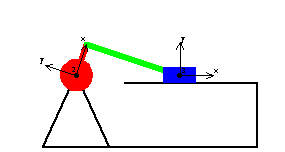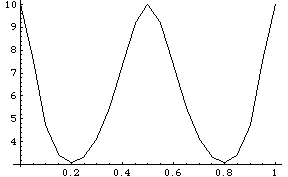10.2 Equilibrium VelocityThis section covers the use of the SetFree and SolveFree functions to find the equilibrium velocity of a mechanism that has velocity-dependent loading. A mechanism must have some loading that is a direct function of velocity for it to have a defined equilibrium velocity. Note that the centrifugal forces in a model, although they are explicitly functions of velocity, are inertial forces and do not appear in a velocity equilibrium analysis. 10.2.1 Example MechanismThis simple planar slider-crank model is presented with little explanation because all of the techniques used in the model have been explored in previous chapters.
The one feature of interest in this model is the velocity-dependent applied loading. Two loads are applied, a driving moment on the crank and a viscous friction on the slider. Note that the driving moment applied to the crank is a function of velocity such that the moment drops to zero as velocity increases. This is done so that the velocity will not approach infinity when the piston is not moving at top-dead-center and bottom-dead-center. This loads the Modeler2D package and defines names for each of the body numbers. Here are the constraints for the slider-crank model. Here are the velocity-dependent applied loads. Note that the force on the slider always opposes its direction of motion. Here is the moment that is applied to the crank by the rotational constraint at T = 0.2.
Out[8]= |  |
Here is the slider-crank model at T = 0.2.

10.2.2 Finding Equilibrium VelocityTo find the equilibrium velocity of a mechanism, a FreeSystem object is built that contains a new set of equations of motion with one or more constraints removed from the model. Velocity equilibrium. The driving constraint is dropped from the slider-crank model to give the model one degree of freedom. This drops the constraint that controls rotation of the crank. This solves the FreeSystem object. Note that the angular velocity of the crank  2d is less than the driven angular velocity of 2 pi. 2d is less than the driven angular velocity of 2 pi.
Out[10]= |  |
To find the equilibrium velocity at a sequence of positions through a full cycle of the mechanism, the InitialCondition option is used to pass SolveFree a new set of initial conditions at each position where the equilibrium velocity is to be found. Thus, it is not necessary to create a new FreeSystem object for each solution point. An option for SetFree and SolveFree. This generates a list of 20 rules to be used as initial conditions for the equilibrium velocity solution. This solves the FreeSystem object at each initial condition in postab. Here is a plot of the equilibrium velocity of the crank through a full cycle of the mechanism.

Out[14]= |  |
Undocumented Graphics Generation
|